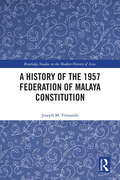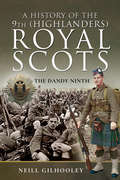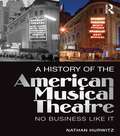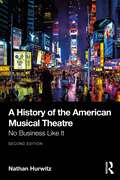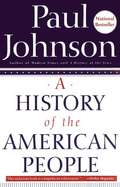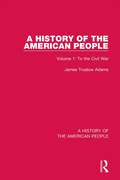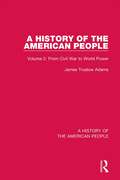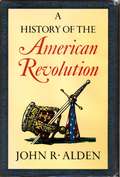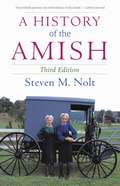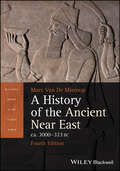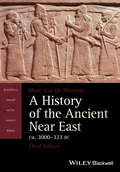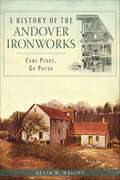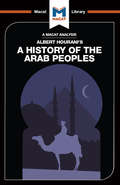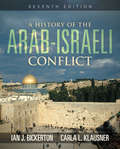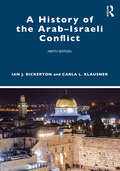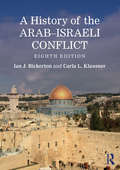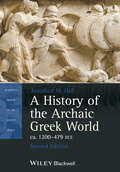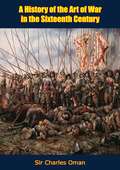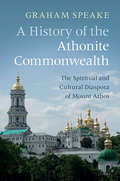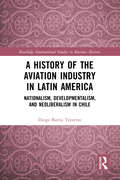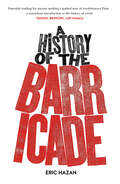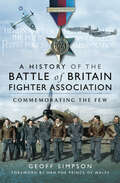- Table View
- List View
A History of the 1957 Federation of Malaya Constitution (Routledge Studies in the Modern History of Asia)
by Joseph M. FernandoFernando examines important aspects of the drafting of 1957 Federation of Malaya constitution related to the system of governance, division of legislative and executive powers, the conceptualisation of citizenship and the roles of the judiciary and election commission.The book sheds new light on the balances that the Reid Commission sought to embed in the constitution and the historical constitutional debates and discussions which greatly shaped the framing of the new federal constitution between 1956 and 1957. Drawing on historical evidence mainly from declassified primary constitutional documents, it analyses the submissions, debates and discussions among the framers and various interest groups during the drafting of the constitution between 1956 and 1957 to discern more clearly the intentions of the framers on many aspects of governance and distribution of powers embedded in the constitutional provisions. This book reveals more deeply the nature and complexity of the constitutional issues faced by the framers and how they attempted to reach compromises between the various interest groups in Malaya.It is a valuable resource for scholars and academics of Malaysian, Asian and Commonwealth constitutional history as well as those interested in history, law, political science and important aspects of governance and distribution of powers in the system of parliamentary democracy.
A History of the 9th: The Dandy Ninth (Pals Ser.)
by Neill GilhooleyThis regimental history chronicles the Dandy Ninth Battalion Royal Scots from its first forays in the Boer War through the brutal fighting of WWI.After suffering the disastrous Black Week of the Second Boer War, the British Army formed a new Highland battalion, the kilted 9th Royal Scots, which became affectionately known as the Dandy Ninth. It sent volunteers to South Africa and established itself as Edinburgh’s kilted battalion, part of the Territorial Force of part-time soldiers.Mobilized in 1914 as part of the Lothian Brigade, the Dandy Ninth defended Edinburgh from the threat of invasion, and constructed part of the landward defenses around Liberton Tower. They were part-time soldiers and new recruits, drawn from the breadth of society, from lawyers to rugby players and artists, such as the Scottish Colorist F.C.B. Cadell, and William Geissler of the Edinburgh School.In the Great War they mobilized to France and Flanders and served in many of the major actions: in Ypres and on the Somme; at Arras and Cambrai in 1917; and during the 1918 German Spring Offensive at St Quentin. In the Advance to Victory, they were with the 15th (Scottish) Division.
A History of the American Musical Theatre: No Business Like It
by Nathan HurwitzFrom the diverse proto-theatres of the mid-1800s, though the revues of the ‘20s, the ‘true musicals’ of the ‘40s, the politicisation of the ‘60s and the ‘mega-musicals’ of the ‘80s, every era in American musical theatre reflected a unique set of socio-cultural factors. Nathan Hurwitz uses these factors to explain the output of each decade in turn, showing how the most popular productions spoke directly to the audiences of the time. He explores the function of musical theatre as commerce, tying each big success to the social and economic realities in which it flourished. This study spans from the earliest spectacles and minstrel shows to contemporary musicals such as Avenue Q and Spiderman. It traces the trends of this most commercial of art forms from the perspective of its audiences, explaining how staying in touch with writers and producers strove to stay in touch with these changing moods. Each chapter deals with a specific decade, introducing the main players, the key productions and the major developmentsin musical theatre during that period.
A History of the American Musical Theatre: No Business Like It
by Nathan HurwitzFrom the diverse proto-musicals of the mid-1800s, through the revues of the 1920s, the ‘true musicals’ of the 1940s, the politicization of the 1960s, the ‘mega-musicals’ of the 1980s, and the explosive jukebox musicals of the 2010s and ’20s, every era in American musical theatre reflected a unique set of socio-cultural factors. This new edition has been brought up to date to include musicals from the last ten years, reflecting on the impact of Covid-19 and the state of the contemporary musical theatre industry.Author Nathan Hurwitz uses these factors to explain the output of each decade in turn, showing how the most popular productions spoke directly to the audiences of the time. He explores the function of musical theatre as commerce, tying each big success to the social and economic realities in which it flourished. This textbook guides students from the earliest spectacles and minstrel shows to contemporary musicals such as Hadestown, Six, and Back to the Future. It traces the trends of this most commercial of art forms from the perspective of its audiences, explaining how staying in touch with writers and producers strove to stay in touch with these changing moods. Each chapter deals with a specific decade, introducing the main players, the key productions, and the major developments in musical theatre during that period. This new edition has been updated to include the 2010s and 2020s, including the impact of Covid-19 on the American Musical Theatre industry, and new features such as end-of-chapter questions for class discussions.Ideal for undergraduate students of Musical Theatre, this is the most comprehensive and accessible guide to the history of the American Musical from the mid-1800s to the present day.
A History of the American People
by Paul Johnson"The creation of the United States of America is the greatest of all human adventures," begins Paul Johnson's remarkable new American history. "No other national story holds such tremendous lessons, for the American people themselves and for the rest of mankind." Johnson's history is a reinterpretation of American history from the first settlements to the Clinton administration. It covers every aspect of U.S. history--politics; business and economics; art, literature and science; society and customs; complex traditions and religious beliefs. The story is told in terms of the men and women who shaped and led the nation and the ordinary people who collectively created its unique character. Wherever possible, letters, diaries, and recorded conversations are used to ensure a sense of actuality. "The book has new and often trenchant things to say about every aspect and period of America's past," says Johnson, "and I do not seek, as some historians do, to conceal my opinions." Johnson's history presents John Winthrop, Roger Williams, Anne Hutchinson, Cotton Mather, Franklin, Tom Paine, Washington, Adams, Jefferson, Hamilton, and Madison from a fresh perspective. It emphasizes the role of religion in American history and how early America was linked to England's history and culture and includes incisive portraits of Andrew Jackson, Chief Justice Marshall, Clay, Lincoln, and Jefferson Davis. Johnson shows how Grover Cleveland and Teddy Roosevelt ushered in the age of big business and industry and how Woodrow Wilson revolutionized the government's role. He offers new views of Harding, Coolidge, and Hoover and of Franklin Roosevelt's New Deal and his role as commander in chief during World War II. An examination of the unforeseen greatness of Harry Truman and reassessments of Eisenhower, Kennedy, Johnson, Nixon, Reagan, and Bush follow. "Compulsively readable," said Foreign Affairs of Johnson's unique narrative skills and sharp profiles of people. This is an in-depth portrait of a great people, from their fragile origins through their struggles for independence and nationhood, their heroic efforts and sacrifices to deal with the `organic sin' of slavery and the preservation of the Union to its explosive economic growth and emergence as a world power and its sole superpower. Johnson discusses such contemporary topics as the politics of racism, education, Vietnam, the power of the press, political correctness, the growth of litigation, and the rising influence of women. He sees Americans as a problem-solving people and the story of America as "essentially one of difficulties being overcome by intelligence and skill, by faith and strength of purpose, by courage and persistence...Looking back on its past, and forward to its future, the auguries are that it will not disappoint humanity." This challenging narrative and interpretation of American history by the author of many distinguished historical works is sometimes controversial and always provocative. Johnson's views of individuals, events, themes, and issues are original, critical, and admiring, for he is, above all, a strong believer in the history and the destiny of the American people.
A History of the American People: Volume 1: To the Civil War (A History of the American People #1)
by James Truslow AdamsOriginally published in 1933, and written by "America’s historian", James Truslow Adams, this volume tells the story of the rise of the American nation encompassing economics, religion, social change and politics from settlement to the Civil War. Due emphasis is given to the inter-connectedness of America with Europe – both in terms of cultural heritage and political and military entanglements. Extensive in size and scope and richly illustrated with half-tones and maps these volumes balance a historical narrative with philosophical interpretation whilst touching on as many aspects of American life and history as possible.
A History of the American People: Volume 2: From Civil War to World Power (A History of the American People #2)
by James Truslow AdamsOriginally published in 1933, and written by "America’s historian", James Truslow Adams, this volume tells the story of the rise of the American nation encompassing economics, religion, social change and politics from settlement to the Civil War. Due emphasis is given to the inter-connectedness of America with Europe – both in terms of cultural heritage and political and military entanglements. Extensive in size and scope and richly illustrated with half-tones and maps these volumes balance a historical narrative with philosophical interpretation whilst touching on as many aspects of American life and history as possible.
A History of the American Revolution
by John AldenThe history of the American rebellion against England, written by one of America’s preeminent eighteenth-century historians, differs from many views of the Revolution. It is not colored by excessive worship of the Founding Fathers but, instead, permeated by sympathy for all those involved in the conflict. Alden has taken advantage of recent scholarship that has altered opinions about George III and Lord North. But most of all this is a balanced history-political, military, social, constitutional-of the thirteen colonies from the French and Indian War in 1763 to Washington’s inauguration in 1789. Whether dealing with legendary figures like Adams and Jefferson or lesser-known aspects of a much picked-over subject, Alden writes with insights and broad eloquence.
A History of the Amish: Third Edition (G - Reference, Information And Interdisciplinary Subjects Ser.)
by Steven M. NoltAuthoritative, thorough, and approachable, this book brings together, for the first time in one volume, the history of the Amish, one of America's most intriguing people. Written by one of the foremost scholars in the field and revised and updated to include a look at how the Amish continue to thrive and grow, despite change, tragedy, and the media's constant fascination with their community. The Amish, one of America's most intriguingly private, unique, and often misunderstood religious communities, have survived for 300 years! How has that happened? While much has been written on the Amish recently, little has appeared about their history. This book brings together for the first time in one volume a thorough history of the Amish people. From their beginnings in Europe through their settlement in North America, the Amish have struggled to maintain their beliefs and traditions in often hostile settings. Now updated, the book gives an in-depth look at how the modern Amish church continues to grow and change. It covers recent developments in new Amish settlements, the community's conflict and negotiation with government, the Nickel Mines school shooting, and the media's constant fascination with this religious people, from reality TV shows to romance novels. Authoritative, thorough, and interestingly written, A History of the Amish presents the deep and rich heritage of the Amish people. Dozens of illustrations and updated statistics.
A History of the Ancient Near East ca. 3000 - 323 BC (Blackwell History of the Ancient World)
by Marc Van De MieroopBLACKWELL HISTORY OF THE ANCIENT WORLD A History of the Ancient Near East ca. 3000–323 BC Fourth Edition “This marvelous book is a classic, and deservedly so. This new edition brings the history up to date with revelations from newly published cuneiform tablets and recent archaeological excavations.” —Amanda H. Podany, Professor of History, Cal Poly Pomona “An outstanding resource for studying the history of the ANE... It is remarkable to find a volume with this subject matter that is as clear and as engaging as what Van De Mieroop has offered here." —Kurtis Peters, RBECS Now in its fourth edition, A History of the Ancient Near East remains one of the most accessible introductions to the rich and complex history of the region available. Integrating original sources, up-to-date scholarship, and extensive supplementary materials, this popular textbook provides student-friendly coverage of the origins of the first cities in Mesopotamia, the growth of the Babylonian and Hittite kingdoms, and the rise of the Assyrian and Persian empires. With an easy-to-understand narrative style, noted historian and lecturer Marc Van De Mieroop guides students through the extraordinary multicultural civilizations of the ancient Near Eastern world. Clear and straightforward chapters describe a wide variety of political, social, and cultural developments, beginning from the invention of writing circa 3000 BC and ending with the conquests of Alexander the Great. This new edition is fully revised to reflect the latest developments in the field, including entirely new sections on recent archaeological discoveries and textual findings. Streamlined and improved chapters are complemented with detailed maps, historical timelines, images and illustrations, and an extensive and up-to-date bibliography. A History of the Ancient Near East ca. 3000–323 BC, Fourth Edition, is an ideal textbook for undergraduate and introductory graduate courses on archaeology or ancient Near Eastern history, as well as a valuable resource for general readers with an interest in the ancient world and the Bible.
A History of the Ancient Near East, ca. 3000-323 BC (Blackwell History of the Ancient World)
by Marc Van De MieroopIncorporating the latest scholarly research, the third edition of A History of the Ancient Near East ca. 3000–323 BC presents a comprehensive overview of the multicultural civilizations of the ancient Near East. Integrates the most up-to-date research, and includes a richer selection of supplementary materials Addresses the wide variety of political, social, and cultural developments in the ancient Near East Updated features include new “Key Debate” boxes at the end of each chapter to engage students with various perspectives on a range of critical issues; a comprehensive timeline of events; and 46 new illustrations, including 12 color photos Features a new chapter addressing governance and continuity in the region during the Persian Empire Offers in-depth, accessible discussions of key texts and sources, including the Bible and the Epic of Gilgamesh
A History of the Andover Ironworks: Come Penny, Go Pound
by Kevin W. WrightSoon after Philadelphia began to exploit New Jersey's largest hematite deposit in 1758, Andover Furnace and Forge began producing the best metal in the world. Its product was so desirable that the newly formed American military wrested control from Loyalist owners in 1778. This frontier industrial outpost endured thirty-five years before labor costs, competition from cheap imports, careless consumption of woodlands and difficulty in transporting its products finally extinguished its fires. Today, repurposed eighteenth-century stone mills and mansions at Andover and Waterloo testify to the combination of rich ore, abundant water power and seemingly endless forests that long ago attracted teamsters, woodcutters, charcoal burners, miners, molders and smelters to the Appalachian Highlands of New Jersey. Local expert Kevin Wright tells the hidden story of the facets and personalities that once made Andover iron so widely coveted.
A History of the Arab Peoples
by Albert HouraniFrom the 7th century, the rise of Islam, thru Muslim societies, the Ottoman Age, the European empires, nation-states to the current Arab unity and disunity.
A History of the Arab Peoples
by Bryan Gibson J. A. BrownFew works of history make as well-structured a case for the importance of studying continuity, rather than change, than Albert Hourani's A History of the Arab Peoples. Hourani’s work had three major aims: to refute the idea that Arab society stagnated between 1000 and 1800; to study the period through the lens of diverse Arab, rather than Muslim, history; and to stress intellectual and cultural continuity. All of these intentions were the product of the author’s evaluation of a great mass of secondary sources, many of them devoted to arguing for ideas that contradicted his, and it demanded considerable skill to synthesize from them a coherent and well-evidenced counter-argument. Hourani was able to do this largely because his grasp of the relevance and adequacy of his predecessors' arguments was second to none; his achievement lies in his ability to reject the reasoning of other historians while still making good use of their evidence. In this task, he was aided by an interpretative skill almost equal to his powers of evaluation; A History of the Arab Peoples is also a monument to the importance of properly understanding the meaning of available evidence.
A History of the Arab-Israeli Conflict
by Ian J. Bickerton Carla L. KlausnerConcise and comprehensive, A History of the Arab-Israeli Conflict presents balanced, impartial, and well-illustrated coverage of the history of the Arab-Israeli conflict. The authors identify and examine the issues and themes that have characterized and defined the conflict over the past century tying in a twenty-first century perspective. The seventh edition exposes readers to recent events in the Middle East. Altering relations between Israel and neighboring states, political and religious uncertainty as a result of the Arab Spring and the increased scrutiny of Iran's nuclear program are explored in this updated edition.
A History of the Arab-Israeli Conflict (6th edition)
by Ian J. Bickerton Carla L. KlausnerThis concise and comprehensive survey presents a balanced and impartial coverage of the history of the Arab-Israeli conflict. The authors identify and examine the issues and themes that have characterized and defined the conflict over the past century. The Sixth Edition examines many of the developments that have occurred during the first decade of the 21st century.
A History of the Arab–Israeli Conflict
by Ian J. Bickerton Carla L. KlausnerComprehensive and analytical, A History of the Arab–Israeli Conflict presents a balanced and impartial overview of this centuries-old struggle. Taking a clear and chronological approach to this complex subject, and placing events in the context of their longer-term histories, Ian J. Bickerton and Carla L. Klausner examine the issues and themes that have characterized and defined the conflict over the course of its history, bringing the coverage up to date with a twenty-first-century perspective. Starting in the nineteenth century, the book moves through the British Mandate, World War II, and the proclamation of the state of Israel, the widening and deepening conflict and attempts at a peace process, the impacts of 9/11 and the Arab Spring, and finally it discusses events to the end of 2021. In a completely revised Conclusion the authors examine how we interpret many of the startling, rapidly changing, and somewhat unpredictable events of the last five years. Illustrated throughout with numerous photographs, updated maps, tables, and chronologies for each chapter, together with extensive relevant and up-to-date documentary sources, further reading, and a glossary of key terms, it is the ideal textbook for all students of the history of the modern Middle East.
A History of the Arab–Israeli Conflict (Mysearchlab Series 15% Off Ser.)
by Ian J. Bickerton Carla L. KlausnerComprehensive and analytical, A History of the Arab-Israeli Conflict presents a balanced and impartial overview of this centuries-old struggle. The authors examine the issues and themes that have characterized and defined the conflict over the course of its history, bringing the coverage up to date with a twenty-first- century perspective. Fully revised throughout, this eighth edition contains:? New and extensive coverage of the developments in the conflict since 2014 Updated Suggested Readings and the incorporation of recent scholarship An additional selection of primary source documents New maps and illustrations. Taking a clear and chronological approach to this complex subject, this book explores recent events in the Middle East in the context of their longer-term history. Illustrated throughout with numerous photographs, maps, tables, and chronologies for each chapter, together with extensive relevant and up-to-date documentary sources and a glossary of key terms, it is the ideal textbook for all students of the history of the modern Middle East.
A History of the Archaic Greek World, ca. 1200-479 BCE (Blackwell History of the Ancient World)
by Jonathan M. HallA History of the Archaic Greek World offers a theme-based approach to the development of the Greek world in the years 1200-479 BCE. Updated and extended in this edition to include two new sections, expanded geographical coverage, a guide to electronic resources, and more illustrations Takes a critical and analytical look at evidence about the history of the archaic Greek World Involves the reader in the practice of history by questioning and reevaluating conventional beliefs Casts new light on traditional themes such as the rise of the city-state, citizen militias, and the origins of egalitarianism Provides a wealth of archaeological evidence, in a number of different specialties, including ceramics, architecture, and mortuary studies
A History of the Art of War in the Sixteenth Century: A History Of The Art Of War In The Sixteenth Century (1937) (Routledge Revivals)
by Charles OmanTHE BEST ACCOUNT OF SIXTEENTH-CENTURY WARFARE BY THE AUTHOR OF A HISTORY OF THE PENINSULAR WARThis is an unrivalled account of sixteenth-century warfare, in which Sir Charles Oman traces the dramatic, far-reaching changes in the military strategy, tactics and organization of the period.Showing how warfare developed, he covers the Great Wars of 1949-1559; military events in Tudor England, including Henry VIII’s continental wars; the French Wars of Religion, 1562-98; the Dutch revolt and war of independence, 1568-1603; and the Turkish offensive against Christendom, from 1520 until the Peace of Sitva Torok in 1606.The battles, sieges and campaigns that Oman examines in detail clarify military development across the century, such as Ravenna (1512), the first battle won by dominance in artillery; Pavia (1525), a ‘victory by surprise’; Pinkie (1547), where an old-fashioned infantry army proved helpless against the combination of all arms; and Arques (1589), exemplifying the defence of a defile by very inferior number.Contemporary maps illustrate many of the actions, and add to the value of this brilliant and lucid history of the art of war.Sir Charles Oman was one of Britain’s foremost historians and a gifted writer. His books, noted for being both scholarly and accessible, include the two-volume History of the Art of War in the Middle Ages, the seven-volume A History of the Peninsular War and others.
A History of the Athonite Commonwealth: The Spiritual And Cultural Diaspora Of Mount Athos
by Graham SpeakeThis book examines the part played by monks of Mount Athos in the diffusion of Orthodox monasticism throughout Eastern Europe and beyond. It focuses on the lives of outstanding holy men in the history of Orthodoxy who have been drawn to the Mountain, have absorbed the spirit of its wisdom and its prayer, and have returned to the outside world, inspired to spread the results of their labours and learning. In a remarkable demonstration of what may be termed 'soft power' in action, these men have carried the image of Athos to all corners of the Balkan peninsula, to Ukraine, to the very far north of Russia, across Siberia and the Bering Strait into North America, and most recently (when traditional routes were closed to them by the curtain of communism) to the West. Their dynamic witness is the greatest gift of Athos to a world thirsting for spiritual guidance.
A History of the Aviation Industry in Latin America: Nationalism, Developmentalism and Neoliberalism in Chile (Routledge International Studies in Business History)
by Diego Barría TraversoThis book analyzes both the Chilean state policies on commercial aviation and the corporate history of the state-owned airline Línea Aérea Nacional (LAN) between 1929 and 1989. The book covers a transition from the early adoption of policies that were nationalist, from both the national security and economic standpoints, through the complete deregulation of the skies and the sale of the state airline to foreign capital. Both processes were implemented by army officers (Carlos Ibáñez del Campo and Augusto Pinochet, respectively). It shows that LAN’s corporate development was marked by the construction of a national aviation paradigm that, albeit initially characterized by a clear definition of nationalism with the state as preeminent, was far from static over time. As from 1929, the role of the state airline, as both a transport service provider and an instrument of public policy, was subject to review. This was due in part to Chile’s political dynamics in the twentieth century in terms of matters such as the level of consensus/dissent about the development model and the role of the state, SOEs, and the private sector in the economy. It also reflected trends in the commercial airline industry globally, technological advances and, as from the 1970s, pressures to liberalize the sector.
A History of the Balkans 1804-1945
by Stevan K. PavlowitchThe Balkans have often been a flashpoint of conflict in European history. The recent civil war has torn the country apart and the region faces an uncertain future. This authoritative study provides an account of the history of the whole area from the first major nationalist rising against its Ottoman rulers in 1804 to the aftermath of World War II. Covering the former Yugoslavia, Albania, Greece, Bulgaria and Romania , it provides a Balkan-wide overview as well as histories of specific states and sets the context to the recent conflict.
A History of the Barricade
by Eric HazanHow the French invented the barricade, and its symbolic impact on popular protests throughout historyIn the history of European revolutions, the barricade stands as a glorious emblem. Its symbolic importance arises principally from the barricades of Eric Hazan's native Paris, where they were instrumental in the revolts of the nineteenth century, helping to shape the political life of a continent. The barricade was always a makeshift construction (the word derives from barrique or barrel), and in working-class districts these ersatz fortifications could spread like wildfire. They doubled as a stage, from which insurgents could harangue soldiers and subvert their allegiance. Their symbolic power persisted into May 1968 and, more recently, the Occupy movements. Hazan traces the many stages in the barricade's evolution, from the Wars of Religion through to the Paris Commune, drawing on the work of thinkers throughout the periods examined to illustrate and bring to life the violent practicalities of revolutionary uprising.From the Hardcover edition.
A History of the Battle of Britain Fighter Association: Commemorating the Few (Battle of Britain)
by Geoff SimpsonIn 1945 it was announced that Allied airmen who had taken part in the Battle of Britain in 1940 would be entitled to the immediate award of the 1939-1945 Star, with Battle of Britain Clasp. This was the only Clasp awarded with the 1939-1945 Star.In the following years holders of the Clasp held informal get-togethers. In 1958 the Battle of Britain Fighter Association (BBFA) was formed, with full membership only available to holders of the Battle of Britain Clasp. Lord Dowding was the first President. Her Majesty Queen Elizabeth the Queen Mother became Patron. That post is now held by HRH The Prince of Wales.As well as organising reunions and providing some welfare assistance to members and widows, the Association has played a key role in researching entitlement to the Clasp and pronouncing on claims for the Clasp. A considerable part of the knowledge existing today on these matters came from the work of successive BBFA archivists, the late Group Captain Tom Gleave and the late Wing Commander John Young.The Association has also become closely associated with the Battle of Britain thanksgiving service held every September in Westminster Abbey.The Association's archives are held in part by the Secretary of the BBFA, Group Captain Patrick Tootal and in part by the Air Historical Branch, RAF (AHB) at RAF Northolt.Geoff Simpson has now been invited by the Association to use these archives as the basis of a book on the history of the organisation.
